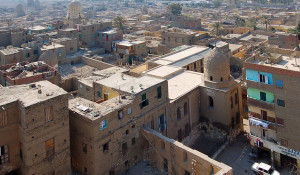In the 14th century, Cairo’s rulers established a cemetery in a desert area east of what was then one of the largest cities in the world, with a population of about 500,000. The rulers and other elites built their mausoleums on the site, the most impressive being the domed mausoleum of Sultan al-Ashraf Qaytbay, completed in 1474, which served as a model for later tombs. The mausoleums typically included large rooms over the underground gravesite where relatives of the deceased could stay during a 40-day mourning period and subsequently visit to pay their respects and obtain blessings. Over time, smaller buildings, having a similar purpose, were built over gravesites in what became known as the “Northern Cemetery,” which now extends for four miles along a six-lane highway.
In the 20th century, Cairo grew rapidly as Egyptians moved in from the countryside. As land to accommodate the city’s increasing millions grew increasingly scarce and expensive, people began finding permanent shelter in the tomb buildings of the Northern Cemetery. Lacking the resources to resettle them, the government tolerated the illegal squatters and their numbers grew. Today, up to a million people live in and around the tombs. Children play amidst the graves while women hang their laundry on ropes strung from one mausoleum to the next. Lacking a better solution, the government has run electric wires and provided water to some of the tombs. Vendors set up at the entrance to the cemetery, selling food and other essentials.
Some children are the third generation living in Cairo’s tombs and have no other place to consider home. In the so-called “City of the Dead,” life goes on.

Comments are closed.